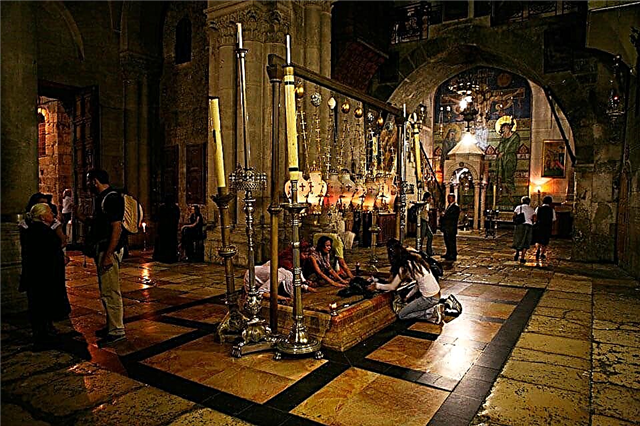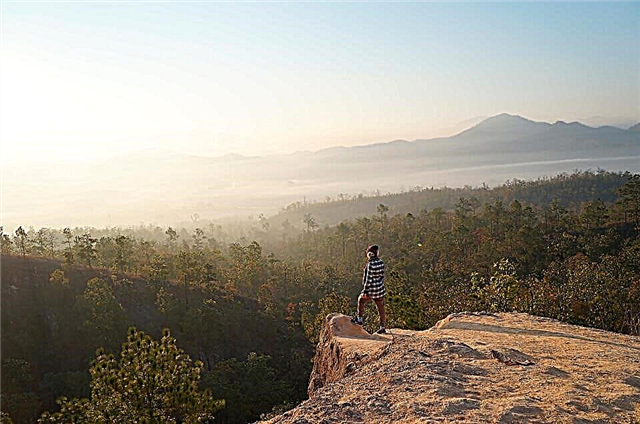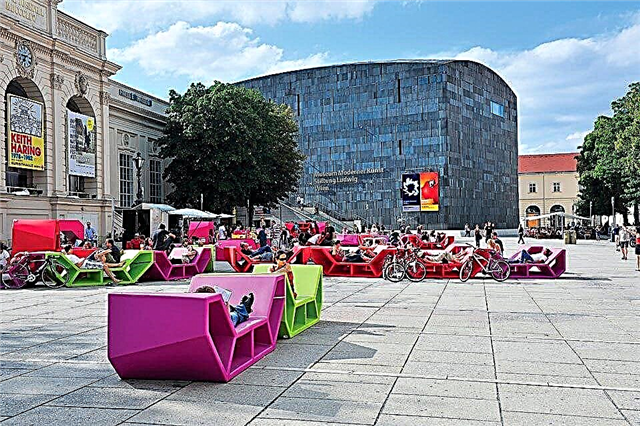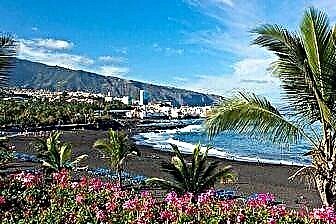The Canary Islands are the pearl of the Atlantic on the beach, a great place to relax in the bosom of pristine nature. Tenerife is the largest island in the archipelago. It is home to numerous national parks, coasts covered with colorful sand, and the majestic Teide volcano.
The swimming season in Tenerife lasts until November. At this time, the gentle waters of the Atlantic Ocean still retain summer heat, even in spite of the decrease in air temperature. The natural attractions of the island are so numerous and varied that it will take more than one week to visit them.
Tenerife is perfect for a wellness holiday. Picturesque hiking trails are laid among its gorges, relict forests allow you to breathe in the healing air with full breast, and sunbathing energizes for many months in advance.

The best hotels and hotels at affordable prices.
from 500 rubles / day
What to see and where to go in Tenerife?
The most interesting and beautiful places for walking. Photos and a short description.
Volcano teide
The volcano is the highest peak in Spain (3718 meters). It is located in the center of Teide National Park. At an altitude of 3555 meters, there is an observation deck, from where almost all of the Canary Islands are visible. The volcano is the most popular natural attraction in Tenerife. A cable car connected to the highway leads to its top.

City of San Cristobal de la Laguna
The city is located in the northern part of Tenerife, not far from the capital of the island - the city of Santa Cruz. San Cristobal de la Laguna was founded in the 15th century by the military leader F. de Lugo after the conquest of Tenerife. Until 1723 it was the capital of the island. Now the city is the cultural and spiritual center of Tenerife. Since 1999, it has been included in the UNESCO lists thanks to its unique colonial architecture, which has been preserved almost unchanged.

Loro park
Nature and entertainment park in the northern part of the island, which is home to up to 500 species of parrots, as well as dolphins, killer whales, penguins, sea lions, turtles, tigers and other animals. Loro Park unites on its territory a zoo, a dolphinarium, a botanical garden and an aquarium. Visitors can not only look at animals, but also visit various shows with their participation.

Siam Park Waterpark
Siam Park is considered the largest European water park. This is a popular place for families with children. There are 25 slides of varying difficulty on the territory of the water park. Siam Park is designed in Thai style, as the owners have a special reverence for the culture of the countries of Southeast Asia. There is an impromptu floating market, Thai restaurants, statues of fabulous creatures from the Thai epic. The Royal Family of Thailand was invited to the opening of the park.

Menagerie Tenerife "Monkey Park"
A small zoo in the south of Tenerife, where, in addition to monkeys, reptiles, panthers, jaguars, exotic birds and even domestic animals live. But the main inhabitants of the park are still primates, there are about 20 species of them. For visitors there is an opportunity to go to the cages of some monkeys, communicate with them and feed them. Since 1991, the park has functioned as a primate breeding center.

Lago Martianez
A unique park consisting of a system of artificial islands and reservoirs located on the shores of the Atlantic Ocean. The fact is that the northern part of Tenerife is less suitable for swimming because of the constant waves, so the creation of such a place has fully justified itself. On the skeletons of the park there are restaurants, beaches, swimming pools and terraces from where you can explore the picturesque surroundings. Lago Martianez was designed by architect S. Manrique in 1971.

Auditorio de Tenerife
Concert Hall located in Santa Cruz - the capital of the island. It was built in 2003 by S. Calatrava Vallas. The building is a picturesque example of modern architecture. The Great Hall of the Auditorio de Tenerife is designed for 1,616 spectators, the chamber hall for 422 people. Outside, there are terraces with views of the Atlantic. From a distance, the silhouette of the building resembles the outline of the Sydney Opera House.

Museum of nature and man
The museum is located in the city of Santa Cruz, it was founded in 1958. The collection consists of archaeological, botanical, paleontological and other artifacts found on the territory of Tenerife and other islands of the Canary archipelago. The museum has a natural science library with an impressive book fund. The exposition is located in a neoclassical building of a former college.

Nuestra Senora de Africa Market
The market is located near the bus station of the capital of Tenerife and is well known outside the Canary Islands. It sells local delicacies, seafood, exotic fruits and vegetables, and traditional Spanish products. On Sundays, a flea market opens at the market, where they sell souvenirs and antiques. The shopping area is located in a typical North African building.

Basilica of Candelaria
The Basilica is located in Candelaria, 20 km away. from the capital of the island. Around the church there are nine statues of the leaders of the Guanche tribe - the indigenous inhabitants of the Canary Islands. The main shrine of the temple is a wooden statue of the Virgin of Candelaria. The monastery complex of the Dominican Order adjoins the building of the basilica. Together they form a single architectural ensemble.

Church of the Immaculate Conception of the Blessed Virgin Mary
The church houses the Holy Cross of the conquistadors, which was brought to Tenerife by the Spanish conqueror F. de Lugo in the 15th century. The temple played an important role in the spread of the Christian religion on the island, therefore it bears the official title of "Mother Church" and is popularly considered the main city cathedral. Until 1638, the church was called "Temple of the Holy Cross", which is where the name of the whole city came from.

Pyramids of Guimar
The pyramids of Tenerife are low, stepped mounds, whose origin is still shrouded in mystery. It is believed that they appeared long before the settlement of the island by the Guanche tribe. For a long time, the pyramids were not of great interest to researchers until their relative similarity with similar buildings in Mexico, Peru, Mesopotamia and a certain astronomical orientation were discovered.

Cave of the Wind
The underground part of Tenerife is replete with a large number of caves, galleries and passages created by the movements of volcanic lava. The Cave of the Wind is the largest in Europe (administratively, the Canary Islands belong to Europe, despite their location). It was formed more than 27 thousand years ago as a result of the eruption of one of the island volcanoes. The cave is an underground complex with stone cascades, terraces and lava lakes.

Mask gorge
Masca is a mountain village located at an altitude of 650 meters on the slopes of the Masiso de Teno. The village is surrounded by picturesque cypress groves and palm thickets, from here originates the gorge of the same name, along which a walking path is laid to the ocean coast. In the 15th century, the village became the last refuge of the indigenous population, who fled from the Spanish conquistadors. Until the 70s. XX century, it remained practically isolated from the outside world.

Infierno gorge
The gorge is located on the territory of the national park of the same name. Due to the unique geographical position, the endemic fauna and flora are still preserved here.The gorge is covered with vibrant tropical vegetation, its appearance does not at all correspond to the frightening name. A 6.5 km long hiking trail has been laid through the mountainous terrain.

Cliffs de Garcia
The cliffs are located in the Teide National Park. They cannot be passed by if you head to the cable car to the volcano. There are many hiking trails in the area that lead to natural viewpoints. The cliffs of de García are a fairly desolate rock landscape, in stark contrast to the lush tropical vegetation of other parts of the island.

Rocks of Los Gigantes
Los Gigantes are located on the western slope of the Teide volcano. They represent an almost sheer wall of stone, which looks picturesque and impressive from the side of the sea. Next to the cliffs is the small town of Los Gigantes, where there are exotic beaches of black volcanic sand. The indisputable advantage of this place is the small number of tourists and the possibility of a relaxing holiday.

Orotava Valley
On the territory of Orotava, before the arrival of the Spaniards, there was a Guanche kingdom called Taoro. The place was not chosen in vain - the valley is surrounded by fertile lands and provided with a large number of fresh water sources. Wealthy immigrants from Europe built magnificent baroque mansions for themselves here, and the mountain slopes were planted with sugar cane. Gradually, a city was formed, which in our time has turned into a tourist attraction of the island.

Esperanza Forest
A dense coniferous forest with unique Canarian pine, eucalyptus and cedar. Local residents consider these forests "a place of power", as the air here has healing properties and a unique coniferous smell. In the morning, a thick fog descends on the trees and the incredible scent of eucalyptus spreads through the forest. Tourists come here for wellness walks and enjoying the views of the rich island vegetation.

Botanical Garden (Puerto de la Cruz)
The garden was founded in the 18th century by order of Carlos III. It should be noted that the monarch was seriously fond of gardening, he was strongly interested in the issue of adaptability of plants to various natural conditions. Tenerife seemed like a great field to experiment. The park was created with the aim of acclimatizing exotic species to the natural conditions of Tenerife. Gradually, the plant diversity of the garden increased to 4 thousand species brought from different parts of the world.

Dragon tree
A unique tree grows in the northeastern part of Tenerife, near the town of Icod de los Vinos. According to various estimates, the tree is more than 500 years old, as it already existed during the Spanish conquest. The weight of the massive crown of the tree reaches 80 tons, the height is 17 meters. The tree was declared a natural monument back in 1917, and its image was placed on the 1000 peseta banknote.

Taoro Park
A park with exotic vegetation located in the city of Puerto de la Cruz. Dozens of species of trees and flowers grow here, picturesque alleys have been laid, artificial waterfalls and fountains have been created. Taoro covers an area of 10 hectares. The park is a popular place for walking among the townspeople and tourists. Here you can breathe fresh air, play sports or admire the blooming flower beds.

El Kaleton
The natural pools of El Caleton were formed by the meeting of hot lava and cool ocean waters during the eruption of the Trevejo volcano in the early 18th century. At high tide, the niches are filled with water and become suitable for swimming. Over time, the pools were equipped with comfortable slopes. The El Caleton complex is located in the town of Garachico. The pools are visited with pleasure by both the Spaniards themselves and foreign tourists.

El Duque beach
A yellow sand beach located on the southern coast of Costa Adeje. El Duc is considered one of the best beaches in Tenerife. It is surrounded by gourmet restaurants, a luxury hotel complex and numerous entertainment venues. The beach is considered the center of the resort life of Tenerife. The beach infrastructure of El Duque is adapted to the most demanding needs.

Benijo beach
A wild beach with black volcanic sand and pebbles, located at the foot of the cliffs in a conservation area. Locals consider it the most picturesque in Tenerife. The beach area is small - 30 meters of coastal strip and about 500 meters of coastline. The coastal cliffs offer magnificent views of the blue ocean waters, which are in stark contrast to the white sea foam off the coast.

Las Vistas beach
The beach is located in the southern part of the island and is one of the longest in Tenerife. Special barrage structures protect Las Vistas from strong waves and currents, so comfortable swimming is possible in the coastal waters. The beach has bars, sports areas, equipment rental and other services. Moreover, there is a special infrastructure for people with disabilities.

Jardin Beach
The beach is located in the popular resort of Puerto de la Tenerife, located in the northern part of the island. Jardin is covered with black volcanic sand and is surrounded by numerous flowering terraces with coconut and banana palms. Lying in the middle of lush gardens, Jardín is a fairly quiet beach suitable for a relaxing holiday, complete relaxation and enjoying the natural beauty.

Las Teresitas beach
A half-kilometer beach with a coastline width of about 70 meters. Las Teresitas is covered with golden sand, which was specially brought here in the 70s. XX century straight from the Sahara Desert. This feature sets Las Teresitas apart from other beaches in Tenerife, as the latter are mostly covered with dark colored volcanic sand. The small village of San Andres is located nearby, and there is a large free parking for tourists.

Cape Teno
The cape is the westernmost point of the island. The terrain is rugged cliffs with a steep descent into the raging waves. From the observation deck, the ocean and the distant outlines of the Tenerife coastline are perfectly visible. There are two lighthouses on the cape - an old stone one of the XIX century and a new, higher one, which was erected in 1987. The premises where the families of the caretakers once lived are available for inspection.

Teide Observatory
The Canary Islands are considered one of the best places for observing the starry sky in the Southern Hemisphere; many European scientists conduct their astronomical research here. The Teide Observatory was founded in 1964 at the Canary Institute of Astrophysics. The institution has international status and is one of the largest observatories in the world. The telescope is located at an altitude of 2390 meters.












